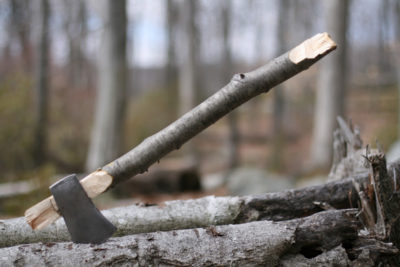For bushcraft/survival applications, I am a BIG fan of the tomahawk. And it’s not just because I was fond of The Patriot movie, but also because I found this type of blade to be an astonishingly useful camping tool.
Tomahawks themselves have been in existence for, well, nobody really knows. However, we do know that they were devices of utility and battle, and had intrinsic ceremonial importance to the Native Americans, and also were highly useful to European militaries and traders. And, this does make sense. After all, this steel bit and straight-handled combination could do just about anything a longhunter, scout, trailman, explorer, or sailor might need out of a belt tool.
If anything, the tomahawk was originally seen as an extremely common (and comparatively cheap) hatchet that could easily be traded like currency. It was also important for tooling and war during the 18th and 19th centuries, but even then it was still seen as basically a small, one-handed ax with a removable handle. It wasn’t until ax handles started getting fancier that the tomahawk became its own thing and not just another type of ax.
Axes were certainly used quite often in those days, but the reason why tomahawks were such a popular, useful tool for fur traders, trappers and trailmen, was because of one simple reason. And that, my friends, brings me to No. 4 of our list on why you should pack in a tomahawk …
4. Break a handle, make a new one
For 19th century trappers, if an ax handle broke in no-where-ville – the wilderness — then you had a heck of a task in trying to repair it. This is another reason why militaries loved tomahawks: If that handle broke, then just find a hardwood stick, whittle it to the approximate fit, and whamo … good as new. Thus, they were a super-inexpensive tooling/weapon option that could be easily repaired in the field.
For modern-day bushcrafters and survivalists, this same advantage applies to us as well. Even if you’re not in the middle of a crisis scenario, a busted ax handle can make for a real pain on a weekend outing with the bushcraft crew. But with a tomahawk, you could even use the bit itself to whittle its own new handle. How crafty.
3. Remove the handle for more precise tasks
Another interesting advantage of the tomahawk is the fact that you can simply remove the handle if needed. Why might you want to do such a thing?
The Trick To Starting Fires In Even The Worst Conditions
It’s because the tomahawk’s head is small enough to hold in your hand, and the blade is only a few inches long. So, you could use it for more precise camp or trail tasks with reasonable dexterity. After sharpening, you could even use it to gut and process game, or carve yourself a spork if your smaller knives have gone missing.
And when you’re done, pop the handle back through the hole, and you can get back to chopping more wood.
2. Keep the handle on for chopping, hammering, etc.
Depending on the tomahawk head design, many of them have a hammer on the side opposite to the bit. Not only would this allow you to chop relatively small logs for the evening fire (and not large logs, because let’s face it, a tomahawk is not an ax), but you also could use the hammer pole for things like driving tent stakes and nails.
This sheer utility of the tomahawk is largely the reason why they’re still being issued and carried by certain parts of the US Armed Forces. It’s an ideal tool for breaching, search and rescue, and like in Vietnam: chopping those darn steel bands off wooden cargo crates.
It is true, the tomahawk is STILL being used by militaries after hundreds of years. Though, while they might not necessarily discuss the hawk’s combat applications with the general public, it’s really a moot point. Soldiers have been bringing the pain with tomahawks for centuries -and from what I know of human nature- we tend to change very little if something just works.
1. Use for utility, or to bring the pain
Seriously, you bring an edged/blunt force weapon with an 18-inch handle into a combat zone, and it will most likely be used for doing combat.
This New Lantern Provides 100,000 Hours of Emergency Backup Lighting
And for good reason, too. In trained hands, the tomahawk will deliver a punishing assault, as it can hook, slice, puncture, traumatize, batter, and is even more effective when paired with a fighting knife.
Through various tomahawk fighting moves, even a proficient knife fighter could be outmaneuvered by a tomahawk, especially if the “hawk” fighter is aware of how diverse his weapon’s advantages really are.
Lastly, yes, hawks can be thrown.
Now I wouldn’t really want to throw my primary fighting weapon at my opponent if I didn’t exactly have another one on my belt, but would I want to throw it at a 30-inch-diameter log target to impress my friends? Absolutely! (That is, if I can get it to stick. Still working on that.)
And there really is something beautiful about a hand-forged tomahawk, adorned with my own addition of brown leather gripping and bronze fasteners. It’s yet another bushcraft tool that has the ability to combine form and function, and that’s what earned the tomahawk a place in my bushcrafter pack.
It’s not a complete one-tool-option, but I certainly would want it on my belt if I only had one tool left.
What are other uses for the tomahawk? Do you agree with the writer? Share your thoughts in the section below:
Could You ‘Live Off The Land’ With Your Gun If Necessary? Read More Here.
 Off The Grid News Better Ideas For Off The Grid Living
Off The Grid News Better Ideas For Off The Grid Living





